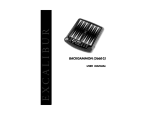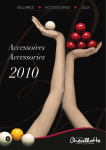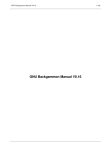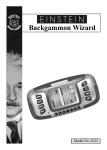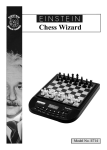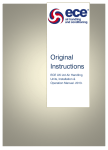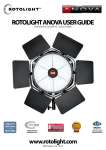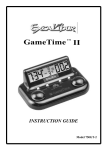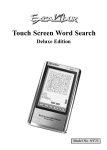Download CarAlarms.com 377 Portable Multimedia Player User Manual
Transcript
LCD Backgammon Operating Manual Model 377 Congratulations on your purchase of Excalibur Electronics’ innovative LCD Backgammon! You’ve purchased a partner who’s always ready for a game—and who can improve as you do! Install the Batteries Using a small Phillips screwdriver, remove the battery-compartment panel screw on the back of LCD Backgammon. Then remove the panel by pulling gently from the top. Install three fresh, alkaline AAA batteries, making sure to follow the diagram in each battery slot so that the polarity (+ or -) of the batteries is correct. Replace the battery compartment panel. Play a Game Right Away After you have installed the batteries, the display will show the backgammon board with all the pips (pieces) on their starting triangles (see figure on right). The LCD will also show SidE. SidE This indicates you are at the first move of the game and ready to roll the dice to see who goes first. If it doesn't display SidE, SidE use a thin object to press RESET. Deciding Who Goes First Press the central direction button diaganolly down to the left or right. This activates the ROLL key. You will see the dice roll, then stop. If the die on the left is less than the die on the right, LCD Backgammon will go first and play it’s move. If the die on the left is larger, you move first so the display will show PLAy. PLAy If doubles (the same value dice) are rolled, the display will show dOUb, dOUb which means the stakes for the game can be doubled. You may accept the double or decline it by pressing the ACCEPT or decline DECLINE keys. After the computer’s move or after your move, the display will show rOLL, rOLL press a ROLL key to roll the dice. Making Your First Move The way you select and make your move is very simple. You always have WHITE. • Press on the SELECT key to choose the pip you want to move. An arrow will point to the pip if it can be legally moved. • To play the die on the left, press the central direction button diaganolly up to the left. This activates the LEFT key. • To play the die on the right, press the central direction button diaganolly up to the right. This activates the RIGHT key. Special Messages During the game the following messages may appear on the display: Primary Key Functions MODE/ON KEY This is a special key, so both its upper and lower labels are gray. Use this key to turn on LCD Backgammon. Also use it to select the secondary function mode of the other keys. You can even use it as a clear or "escape" key to exit any of the special modes like OPTIONS, LEVEL, and CONTRAST. PASS - This means you or the computer cannot use the dice or remaining die to make a legal move. Press either ROLL key to continue play. rOLL - Press either ROLL key to roll the dice. dOUb - This means the computer wants to double the stakes, because it thinks it is winning. To accept the double, press the ACCEPT key. To decline the double press the DECLINE key, BUT this means the computer wins, so the game will end. HINT KEY Press this key if you want to get hints from your LCD Backgammon partner. It shows an arrow to the pip it thinks is the best one to move. It shows another arrow pointing to the triangle to which it should be moved. If you must move in from the bar, it will show an arrow to your best entry triangle. To make the hint move, just press the ACCEPT key. LOSE - Shows that the game is over, and that you have lost. Press any key to continue. _YOU Won - Shows that the game is over, and that you have won. Press any key to continue. SCORE KEY • Before a game begins, press this key to see your winnings, rating, and other statistics (see “Rating and Scoring” section). • During the game, press this key to see your pip score. This is the total of all dice you need to roll in order to win the game. Press this key a second time to see the computer’s pip score. Special Features and Function Keys Features are controlled by the function keys—the black keys on your LCD Backgammon. But there are more special features than there are keys! So each one has two labels, one above and one below. SELECT KEY Press this key to select which pip you would like to move. It will only point to pips that can be legally moved. The black label below each key shows the primary function of the key. The gray label above the key shows its secondary function. DOUBLE KEY Press this key if you think you are winning and want to double the stakes. You can only double if no one has the cube, or you have the cube. You have the cube when a WHITE cube and it’s value is shown on the screen. You may only dou- Below are the features available to you through the primary functions. Remember, to access any of these features, you simply push the proper key, looking at the black label below the key. 2 Your Excalibur LCD Backgammon is packed with features! Each key has two labels. To activate the feature named below the key, just press the button. To enjoy the feature given above the key, first press MODE/ON and then the button. ble before you roll the dice for your turn. First press of the OPTIONS key - TAKEBACK KEY This key lets you take back a move or moves you’ve decided against, BEFORE you have pressed the ROLL key. Pressing the ROLL key enters your move, so the computer can roll the dice for it’s move. bE: bE EP - Sound is on. OFF KEY This turns the unit off, automatically saving a game in progress. Use the ON key to turn the unit back on. If no key has been pressed for 5 minutes, LCD Backgammon will automatically turn off, saving your game position. Use the ON key to resume the game. CU: CU bE - The doubling cube can be used. bE EP - Sound is off. However, the low tone for illegal moves or illegal key presses does not turn off. Second press of the OPTIONS key - CU bE - Cube is off, so no doubling will be permitted. Third press of the OPTIONS key rA: rA tE - Rating is on, so games results will be scored. rA tE - Rating is off. Turn the rating off for player mode, or if someone else plays the game. This will prevent your rating and game statistics from being updated. Secondary Key Functions Pressing the MODE key will show 2nd on the display. This means the second function mode marked by a gray label above the key is active. You may press MODE again to stop using a secondary function. Fourth press of the OPTIONS key PL: PL yr - Player is on, so you may play against another player, and not against the computer. PL yr - Player is off, which means you are playing against the computer. OPTIONS KEY Pressing the OPTIONS key repeatedly will display all selectable options. To select or change an option, use the ACCEPT or the DECLINE key. A colon (:) will be shown, if the option has been accepted. Fifth press of the OPTIONS key AU: AU tO - Autoroll is on, so the ROLL key does not need to be pressed once the game has started. AU tO - Autoroll is off. 3 o/n KEY (CONTRAST) negative if you have lost more points than you have won. Press this key repeatedly to adjust the display contrast to one of eight settings. This allows you to compensate for differences in lighting and battery strength. The second press of the SCORE key will show RAT in dots on the top half of the backgammon board. The top display will show your rating. Rating value evaluations are as follows: LEVEL KEY The level may be checked or changed before you roll your dice. Pressing this key will show the current level, for example:LE LE 8. 8 You can change the level by re-pressing the LEVEL key. Each press increases the level by 1. When the display shows the desired level, press the MODE key. Generally, the higher the level you select, the better your LCD Backgammon will play. Level 1 is the weakest, and plays a running game from the start of the game. This means it will tend to first play it pips that are furthest from its home. Level 8 is the strongest and is designed for tournament players. 200 to 1000 Beginner 1001 to 1500 Intermediate 1501 to 2000 Advanced 2001 to 2200 Expert 2201 an up Champion On level 8, the computer’s rating is assumed to be 1536. On level 1 the computers rating is assumed to be 384. The computer recomputes your rating after every game depending on the level, cube value, and your established rating before the game. NEW GAME KEY You can begin a new game at any time. The third press of the SCORE key will show Won in dots on the top half of the backgammon board. The top display will show the number of games you have won. If you request a new game before the computer has begun to bear off it’s pips, the scoring feature will not be affected. You therefore have the ability to protect your rating by cheating if you are off to a bad start. Otherwise the computer will assume you are resigning and score the game as a loss for you. The fourth press of the SCORE key will show TOT in dots on the top half of the backgammon board. The top display will show the total number of games played. The next two presses of the SCORE key will show GAM in dots on the top half of the backgammon board. The top display will show the number of gammons you have made, then the number of gammons the computer has made. Rating and Scoring At the start of a game the display shows SidE. SidE At this point the first press of the SCORE key will show SCR in dots on the top half of the backgammon board. The top display will show your score or accumulated winnings. This score can be The next two presses of the SCORE key 4 will show BAK in dots on the top half of the backgammon board. The top display will show the number of backgammons you have made, then the number of backgammons the computer has made. Rules Of The Game The Objective The objective of the game is to be the first player to move all their 15 pieces around the Board into their home table(refer to the figure on page 1), and then remove them or “bear off” from the Board . The number off bear-off pips will be indicated by numbers in the upper left corner of the display. See figure below: Operation Shortcuts It is possible to play an entire game by just using the central directional joy pad. Pressing in the UP direction will act like the SELECT key had been pressed. Pressing in the LEFT direction will act like the LEFT key had been pressed. Pressing in the RIGHT direction will act like the RIGHT key had been pressed. Pressing in the DOWN direction will act like the ROLL key had been pressed. Playing the Game For easier move entry, if you have only one die remaining to play, either key may be pressed. • Each player moves their pieces according to the numbers shown on the dice. Computers can sometimes "lock up" due to static discharge or other electrical disturbances. If this should happen, use a slim, pointed object to press the buton marked “RESET.” • A player must, if possible, play both parts of his roll. • A player moves the same pieces or any two pieces, once for the number on one die. And again for the number on the other die. But you cannot add the total of the two die. • If it is impossible to use both parts of a roll, a player must (if possible) use the higher part. Then the player must “pass”. • If a player is unable to use any part of his roll to move any of his pieces, he must “pass” and it is his opponent’s turn again. • When a player rolls doubles, you can make four moves on the same piece or any combination of pieces you choose. 5 • Each player moves their pieces from his opponent’s inner table to his inner table as shown below: The three type of moves shown are: I - clear of any other pieces II - occupied by one or more of his own pieces. III - occupied by any singleopponents’s piece (called a blot). You may hit the opponent’s piece and move it to the BAR. may move any of your other pieces. For example, refer to the figure below: If you have a piece on the BAR and throw 2 and a 4, you cannot re-enter your pieces on point 2 or 4 since they have been closed by your opponent. You would need to “pass”. You can only get off the BAR if you land on points 1,5, and 6. If you land on point 5, your opponent’s piece will be removed to the BAR. How To Bear Off • When all 15 pieces are in a player’s inner home table, the player must remove or “bear off” the pieces from the board. • If a number thrown is higher than any points occupied by the player’s pieces, then you may bear off from the highest points. For Example, if you throw a 6 and a 4, you can bear off from points 5 and 4, because you have no pieces on point 6. see below: • When you have two or more pieces on a point it is called a “closed point”. Your opponent is not permitted to land on it. See the figure below: How To Get In From Bar • If the number thrown corresponds exactly to a point with a players’s piece, the player may bear it off. • If a number thrown is lower than any • If one of your pieces has been placed on the BAR, you must re-enter into your opponents inner home table before you 6 points occupied by the player’s pieces, then you must move the piece further along in your home table. Hints On Strategy Early in play it is best to leave your back pieces alone, unless you can bring them out on good throws (6-5, 6-6, 4-4, or by hitting a blot). As the game moves on, you should try to make a prime which is six consecutive closed points. Your opponent cannot move over a prime, so you have blocked him in, thus increasing your chances of winning. Gammons If the loser has not managed to bear off any men but does not have any of his own men in the winner’s inner table or on the bar, then the winner scores 2 points. This situation is called a “Gammon”. If the loser has not managed to bear off any men and also has at least one man on the bar or in the winner’s inner table, then the winner has made a “Backgammon” and his basic score is 3 points. You should hit your opponent’s men when he leaves blots far from you home table. Enemy blots in your home table are dangerous to hit, since your opponent may re-enter and hit your blot sending you back to the bar and your inner table. The winner’s basic score is then multiplied by the value of the doubling cube to obtain the actual number of points scored. As your opponent makes points in his home table you should play more cautiously because it will be more difficult for you to enter a man after being hit. Doubling Cube Use of the doubling cube can make the game much more exciting. The cube has its faces numbered 2,4,8,16,32 and 64. At the start of the game the cube is “in the middle”, it does not have any effect at that stage. If you use the doubling cube feature, you should know when to offer a double. If you double too soon, your opponent’s position may improve and he will redouble; if you double too late, your opponent will not accept the double and your win may have missed a gammon or backgammon. Before he rolls the dice to make a move, a player may take the cube from “the middle” and offer it to his opponent. If the opponent accepts the doubling cube, it is turned up with the number 2 showing on it. On any of the opponents turns, before he rolls his dice, he may offer the doubling cube to the other player. If the other player accepts it, the face with the 4 is turned up and the cube is held by that player. This can continue to happen until the maximum cube value of 64 is reached. 7 Special Care • Install batteries so that the polarity (+ and -) matches the diagrams in the battery compartment. • Use only batteries of the same type and equivalency. • Remove exhausted batteries from the unit. • Do not short circuit battery terminals. • Avoid rough handling such as bumping or dropping. • Avoid moisture and extreme temperatures. For best results, use between the temperatures of 39ºF and 100ºF (4ºC and 38ºC). • Clean using only a slightly damp cloth. Do not use cleaners with chemical agents. Battery Information • Your LCD Backgammon uses 3 “AAA” batteries. • Do not mix old and new batteries. • Do not mix alkaline & standard or rechargeable batteries. Excalibur Electronics reserves the right to make technical changes without notice in the interest of progress. Limited One-Year Warranty EXCALIBUR ELECTRONICS, INC., warrants to the original consumer that its products are free from any electrical or mechanical defects for a period of ONE YEAR from the date of purchase. If any such defect is discovered within the warranty period, EXCALIBUR ELECTRONICS, INC., will repair or replace the unit free of charge upon receipt of the unit, shipped postage prepaid and insured to the factory address shown at right. The only authorized service center in the United States is: Excalibur Electronics, Inc. 13755 SW 119th Ave Miami, Florida 33186 U.S.A. Phone: 305.477.8080 Fax: 305.477.9516 www.ExcaliburElectronics.com Ship the unit carefully packed, preferably in the original carton, and send it prepaid, and adequately insured. Include a letter, detailing the complaint and including your daytime telephone number, inside the shipping carton. The warranty covers normal consumer use and does not cover damage that occurs in shipment or failure that results from alterations, accident, misuse, abuse, neglect, wear and tear, inadequate maintenance, commercial use, or unreasonable use of the unit. Removal of the top panel voids all war ranties. This warranty does not cover cost of repairs made or attempted outside of the factory. If your warranty has expired and you want an estimated fee for service, write to the above address, specifying the model and the problem. Any applicable implied warranties, including warranties of merchantability and fitness, are hereby limited to ONE YEAR from the date of purchase. Consequential or incidental damages resulting from a breach of any applicable express or implied warranties are hereby excluded. Some states do not allow limitations on the duration of implied warranties and do not allow exclusion of incidental or conse quential damages, so the above limita tions and exclusions in these instances may not apply. DO NOT SEND YOUR UNIT WITHOUT RECEIVING AN ESTIMATE FOR SERVICING. WE CANNOT STORE YOUR UNIT! 377-010627-02 8








